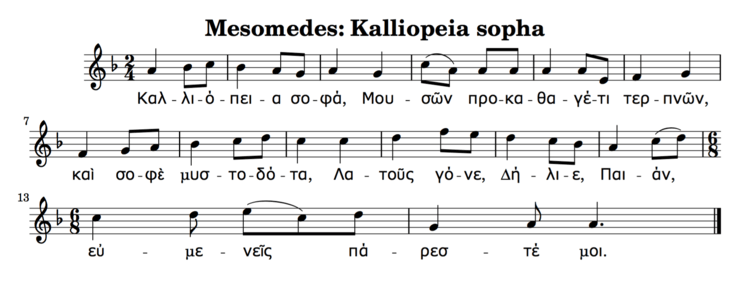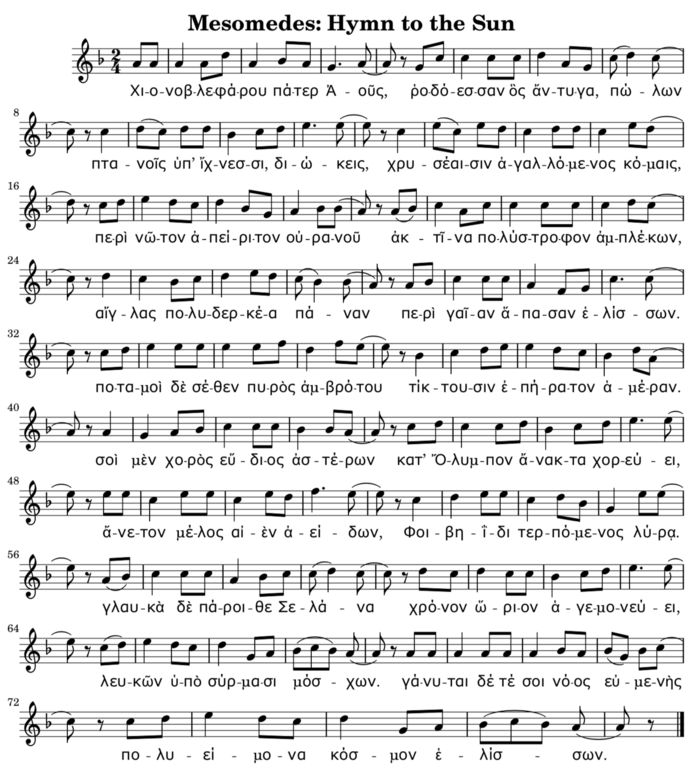Mesomedes
Mesomedes of Crete (Ancient Greek: Μεσομήδης ὁ Κρής) was a Roman-era Greek lyric poet and composer of the early 2nd century AD.
He was a freedman of the Emperor Hadrian, on whose favorite Antinous he is said to have written a panegyric, specifically called a Citharoedic Hymn (Suidas). Two epigrams by him in the Greek Anthology (Anthol. pal. xiv. 63, xvi. 323) are extant, and a hymn to Nemesis. The hymn is one of four which preserve the ancient musical notation written over the text. Two other hymns, one to the muse Calliope and one entitled Hymn to the Sun, formerly assigned to Dionysius of Alexandria, have also been attributed to Mesomedes. In an article[1] published in 2003, Annie Bélis proves that the Berlin musical papyrus (inv. 6870) contains a Paean to Apollo written by Mesomedes. A total of 15 poems by Mesomedes are known.
Mesomedes continued in the Musaeum in Alexandria even after Hadrian's death (138); there the Historia Augusta reports that during Antoninus Pius' reign, 138-161 his state salary was reduced. The emperor Caracalla 212-217 honored Mesomedes with a cenotaph approximately a 50–60 years after his death.
Prior to the discovery of the Seikilos epitaph in the late 19th century, the hymns of Mesomedes were the only surviving written music from the ancient world.[2] Three were published by Vincenzo Galilei in his Dialogo della musica antica e della moderna (Florence, 1581), during a period of intense investigation into music of the ancient Greeks. These hymns had been preserved through the Byzantine tradition, and were presented to Vincenzo by Girolamo Mei.
See J. F. Bellermann, Die Hymnen des Dionysius und Mesomedes (1840); C. de Jan, Musici scriptores graeci (1899); S. Reinach in Revue des études grecques, ix (1896); Suidas, s.v.
Hymns
Prayer to the Muse
The dialect of this hymn is different from the others (Ionian rather than Doric), and the style is also slightly different; for this reason J.G. Landels believes that it is probably not by Mesomedes.[3]
Ἄειδε μοῦσά μοι φίλη, |
Prayer to Calliope and Apollo
Καλλιόπεια σοφά, |

Hymn to the Sun (Hymn to Apollo)
Χιονοβλεφάρου πάτερ Ἀοῦς, |
Father of the Dawn with her snow-white eyelids, |

Literature
- Vincenzo Galilei, Dialogo Di Vincentio Galilei Nobile Fiorentino Della Musica Antica, Et Della Moderna (Fiorenza, 1581) (google), p. 97
- Johann Friedrich Bellermann, Die Hymnen des Dionysius und Mesomedes. Text und Melodieen nach Handschriften und den alten Ausgaben bearbeitet von Dr. Friedrich Bellermann (Berlin, 1840) (google)
- Rheinisches Museum für Philologie. Neue Folge. Neunter Jahrgang (Frankfurt am Main, 1854) (google); p. 306–311: Theodor Bergk, Zu den Hymnen des Dionysius und Mesomedes
- Karl von Jan (Latin: Carolus Janus), Musici scriptores graeci. Aristoteles Euclides Nicomachus Bacchius Gaudentius Alypius et melodiarum veterum quidquid exstat. Recognovit prooemiis et indice instruxit Carolus Janus. Annexae sunt tabulae (Lipsia, 1895) (google-US), p. 454ff.
- Musici scriptores graeci. Recognovit prooemiis et indice instruxit Carolus Janus. Supplementum, melodiarum reliquiae (Lipsia, 1899) (google-US)
- Revue des études grecques. Tome IX. Année 1896 (Paris, 1896) (google-US); p. 1–22: Théodore Reinach, L'hymne a la Muse
- Landels, John G. (1999). Music in Ancient Greece and Rome. Routledge. ISBN 0-203-04284-0.
- Pöhlmann, Egert; West, Martin L. (2001). Documents of Ancient Greek Music: The Extant Melodies and Fragments, edited and transcribed with commentary by Egert Pöhlmann and Martin L. West. Oxford: Clarendon Press. ISBN 0-19-815223-X.
In anthologies:
- Richard François Philippe Brunck, Analecta veterum poetarum graecorum. Editore Rich. Fr. Phil. Brunck. Tom. II. (Argentoratum; ed. IV.: Argentoratum, 1785) (google; ed. IV.: google), p. 292f.
- Richard François Philippe Brunck and Christian Friedrich Wilhelm Jacobs, Anthologia graeca sive poetarum graecorum lusus. Ex recensione Brunckii. Tom. III. Indices et commentarium adiecit Friedericus Iacobs (Lipsia, 1794) (google), p. 6f.
- Jean François Boissonade de Fontarabie, Ποιητῶν ἑλληνικῶν συλλογή. τόμ. ιεʹ. – Poetarum graecorum sylloge. Tom. XV. — Ἀλκαῖος Σαπφώ Σιμωνίδης σύνεσιος λυρικοὶ διάφοροι. – Lyrici graeci curante Jo. Fr. Boissonade (Paris, 1825) (google), p. 49ff.
- Anthologia lyrica Anacreontea et Anacreontis aliorumque lyricorum graecorum selecta fragmenta et scolia continens. Edidit cum notis criticis et metrorum expositione Fridericus Mehlhorn (Lipsia, 1827) (google), p. 70f.
- Anthologia graeca sive delectus poesis elegiacae melicae bucolicae. Scholarum in usum adornavit Nicolaus Bachius (Hannovera, 1838) (google), p. 128
- James Donaldson, Lyra Græca: Specimens of the Greek Lyric Poets, from Callinus to Soutsos. Edited, with critical Notes, and a biographical Introduction, by James Donaldson (Edinburgh & London, 1854) (google), p. 96f.
- Theodor Bergk, Anthologia lyrica continens Theognidem, Babrium, Anacreontea cum ceterorum poetarum reliqiis selectis. Edidit Theodorus Bergk (Lipsia, 1854) (google), p. 403f.
- Anthologia lyrica continens Theogni[de]m, Babrium, Anacreontea cum ceterorum poetarum reliqiis selectis. Curavit Theodorus Bergk (Lipsia, 1868) (google), p. 522ff.
Notes
- Bélis, Annie (2003). "Le 'Péan de Berlin' : une relecture". Revue des études grecques (in French). 116: 537–558. Cite journal requires
|journal=(help) - The notes to an ode of Pindar presented in a book by Athanasius Kircher (book cover, notes to the ode) are now considered to be unauthentic.
- Landels, John G. 1999. Music in Ancient Greece and Rome. London and New York: Routledge; p. 254.
- Cosgrove, Charles H. (2011). An Ancient Christian Hymn with Musical Notation. Mohr Siebeck. pp. 69, 70.
- Text from Pöhlmann & West (2001), pp. 97–99.
- Landels, John G. (1999). Music in Ancient Greece and Rome, p. 256, but reading 'thread' (πάναν) for 'fount' (παγάν).
References

- Egert Pöhlmann: "Mesomedes", Grove Music Online ed. L. Macy (Accessed November 30, 2005); (subscription access)
External links
- "Hymn to the Muses" (PDF) and "Hymn to Nemesis" (PDF) in Greek with brief glosses/commentary
- 'Hymn to Nemesis' in English translation with Greek original
- Homepage of the Ensemble Musica Romana for ancient music (English and German)
- Ensemble Kérylos a music group directed by scholar Annie Bélis and dedicated to the recreation of ancient Greek and Roman music. Its recording D'Euripide aux premiers chrétiens contains the 5 known works by Mesomedes (tracks 9 to 13).
- Prayer to Calliope and Apollo. Sung to the lyre by Stefan Hagel.
- Hymn to the Sun. Petros Tabouris Ensemble.
- Hymn to Nemesis. Ensemble de Organographia.
- Hymn to Nemesis/ Petros Tabouris Ensemble.